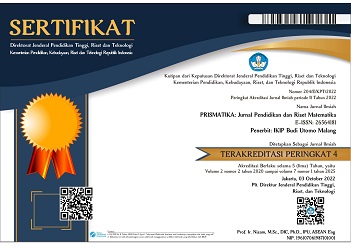KENDALA PEMBELAJARAN MATEMATIKA SECARA DARING DAN LURING SAAT PANDEMI COVID-19 TERHADAP SISWA AUTIS
Abstract
This research aims to describe the obstacles to online and offline mathematics learning for autistic students in class VIII SMPLB Bintoro Jember. This research conducted was qualitative research through a descriptive approach. The subjects were the class teacher. The collection of data using interviews and documentation studies. Data analysis with data reduction stages and then data presentation after that drawing conclusions. The validity of the data using triangulation techniques. The research obtained the following results: (1) Implementation of online and offline mathematics learning for autistic students in class VIII SMPLB Bintoro Jember which was carried out by class teachers assisted by smartphones with the WhatsApp application. (2) The difficulties experienced by teachers in implementing online mathematics learning for autistic students in class VIII, which consist of student factors themselves, student focus and an environment that is different from school. (3) The factors that cause a decrease in learning outcomes in autistic students, which consist of limited time, cellphone and signal constraints and parents who cannot accompany autistic students in learning because they are busy. The conclusion obtained was that there was a decrease in the mathematics learning outcomes of class VIII autistic students before the pandemic with an average of 74.75, while during the pandemic it was an average of 70.75. Even though there are several obstacles in learning that cause a decrease in the value obtained by autistic students in learning during a pandemic as much as 4%, the implementation of online learning can be stated as good and smooth with the help of a smartphone using the WhatsApp application.
References
Daniel, S.J. 2020. Education and the COVID 19 pandemic. UNESCO IBE. https://doi.org/10.1007/s11125-020-09464-3
Halimah, L., Pandikar, E., Azhari, N., Hidayah, Y. 2021. Upaya Guru dan Orang Tua dalam Membangun Karakter Mandiri Siswa Autis di Sekolah Luar Biasa Negeri A Kota Cimahi. Jurnal Hurriah: Jurnal Evaluasi Pendidikan dan Penelitian. 2(3). 41-63. https://doi.org/10.5806/jh.v2i3.23
Hendita, G., Kusuma, A., Si, S., Cs, M., & Oktana, L. (2012). Sistem Identifikasi Penyakit Autis Anak Berbasis Web. 1(1), 29–41.
Ibrahim. (2012). Pembelajaran Matematika Teori dan Aplikasinya. Yogyakarta: Suka-Press.
Lutfiyah. (2020). Ketuntasan Belajar Matematika Masa Pandemi Covid-19 Program Televisi Edukasi Belajar dari Rumah. Jurnal Laplace. 3(2). 142-150. https://doi.org/10.31537/laplace.v3i2.380
Minsih, Nandang. J.S, Kurniawan, W. 2021. Problematika Pembelajaran Online Bagi Anak Berkebutuhan Khusus Di Sekolah Dasar Masa
Pandemi Covid-19. Jurnal Basicedu. 5(3). 1252-1258. https://doi.org/10.31004/basicedu.v5i3.876
Moore, J. L., Dickson-Deane, C., & Galyen, K. (2011). E-Learning, online learning, and distance learning environments: Are they the same? Internet and Higher Education. https://doi.org/10.1016/jiheduc.2010.10.001.
Pamuji. 2007. Model Terapi Terpadu Bagi Anak Autisme. Jakarta: Departemen Pendidikan Nasional Direktorat Jendral Pendidikan Tinggi Direktorat Ketenagaan.
Panglipur, I, R., Putra, E, D. (2019). Prinsip Bentuk Geometri untuk Kemudahan Pembelajaran Matematika Penyandang Disabilitas. Histogram: Jurnal Pendidikan Matematika, 3(2), 182 – 188, doi:http://dx.doi.org/10.31100/histogram.v3i2.429.
Satori, Djam’an & Komariah, Aan. 2010. Metodologi Penelitian Kualitatif. Bandung: Alfabeta.
Sugiyono.2017. Metode Penelitian Kuantitatif Kualitatif dan R&D.Bandung: Alfabeta.
Sunendar, Dadang, Dkk. (Tim Penyusun KBBI Edisi Kelima). (2020). Kamus BesarBahasa Indonesia. Jakarta : Badan Pengenbangan Dan Pembinaan Bahasa Kementrian Pendidikan Dan Kebudayaan Republik Indonesia.
Susilana, R & Riyan,C,. 2010.Media Pembelajaran: Hakikat, pengembangan, Pemanfaatan, dan Penilaian. CV: Wacana Prima.
Undang-Undang No. 20 Tahun 2003 tentang Sistem Pendidikan Nasional.
Wekke, I. S., & Hamid, S. (2013). Technology on Language Teaching and Learning: A Research on Indonesian Pesantren. Procedia-Social and Behavioral Sciences, 83, 585–589. https://doi.org/10.1016/J.SBSPRO.2013.06.111







.png)




